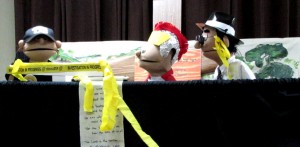by Carol
Sometimes they call me the Puppet Lady. I’ve been doing puppets since I was in first grade.
Over the years, I’ve made and performed with many kinds of puppets around the U.S. and in foreign countries. I’m far from a pro, but I have a lot of experience.
I few weeks ago, I moved my church membership, and now I am up over my eyebrows in puppets again.
When the pastor saw “puppets” on a list of things I’ve done, he immediately introduced me to a closet full of Muppet-style puppets. (More on church storage closets in the near future….) They adopted me at first sight.
I’m just a volunteer. How did we move from “puppets stuffed in a closet” to full-blown “puppet world” in less than 6 weeks?
1. Pastor’s vision – The pastor has known me for several years, but he didn’t realize that I had worked with puppets.
Suddenly, a closet full of little stuffed characters jumped to life in his mind as a ministry with important potential.
2. Ideal opportunity – The pastor linked me with the VBS director, who immediately latched onto the idea of the puppets telling the daily Bible story.
3. Connectors – The youth ministry had used the puppets a few times, so the youth pastor’s wife volunteered to help for VBS. She knows everyone in the church. We talked about what / who I needed, and she knew people with those interests and abilities. A few other folks helped connect me, too. I could not have found the voice actors, puppeteers, and other resources on my own in a church that was so new to me.
In a few short weeks, I have gotten to know a lot of people, they have gotten to know me at my best (and stressed — another story for later), and we have had a great experience together in a ministry I love doing.
Shouldn’t all volunteers have that kind of inaugural experience in a new church or ministry?



